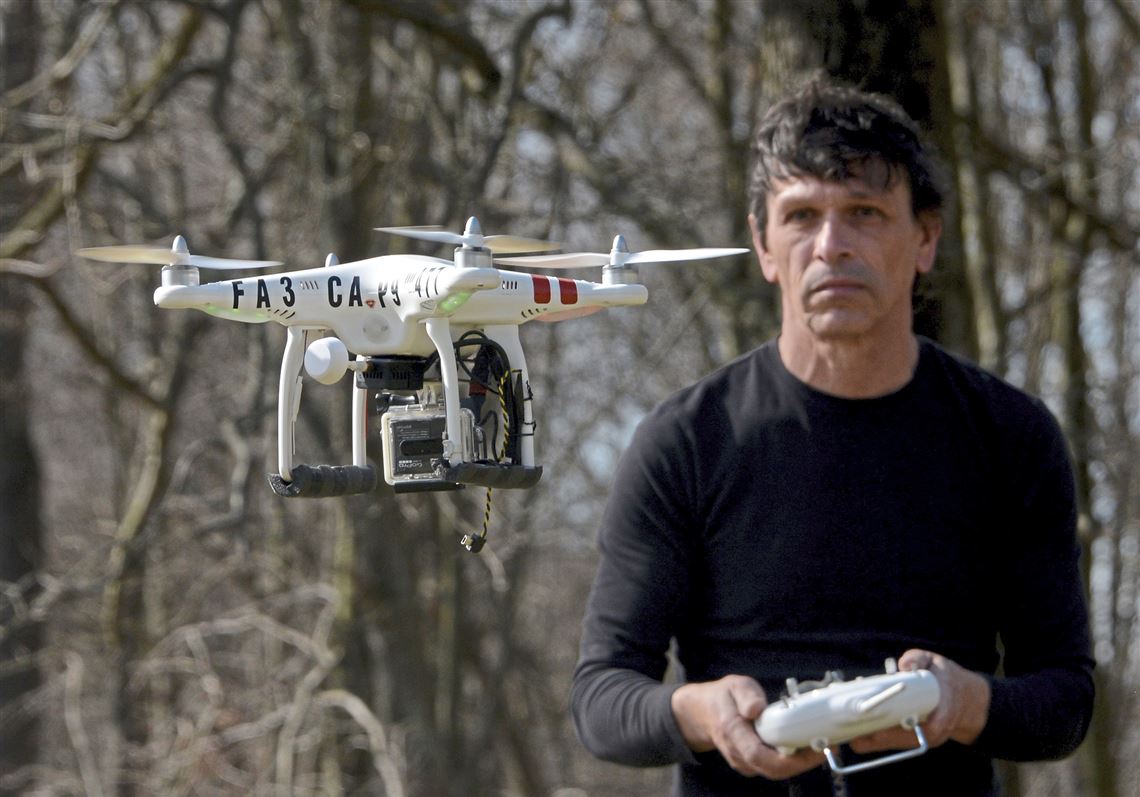In November 2017, a body was spotted in the Ohio River near the Dashields Dam in Crescent. The current was too swift to safely send rescuers, so a small unmanned aerial vehicle, commonly called a drone, was sent to record video.
From those images it was determined the body was a female with tattoo markings. A family identified the body from those images.
“The imagery was of such high quality that we would never be able to get without the drone technology,” Allegheny County police Detective Mike Feeney said.
The next day, the body disappeared in the river, and has yet to be recovered. But at least the family had answers, Detective Feeney noted.
In a similar case, officials were able to search the shoreline and water with the aid of a drone after two women and their kayaks went over a dam on the Ohio River near Sewickley last year. The first woman’s body was found immediately, but authorities attributed the recovery of the second, made days later, to the use of a drone.
“Technology can’t replace a trained helicopter crew, but there are times you employ this in a dangerous area,” Detective Feeney said.
In cases where officials want to quickly alert the public to an emergency situation, a drone’s video downlink will send a live TV signal back to a remote truck, which is then forwarded via a microwave link to a television station.
Eye in the sky
Drones are remotely controlled aircraft, some weighing less than a pound, and directed by a person with a control system, like a tablet, or with on-board computers.
The software inside some drones allows them to operate autonomously based on coordinates of the Global Positioning System (GPS) satellite-based navigation system.
For military usage of large, unmanned aircraft in Afghanistan, remote piloting involves a rigorous screening process followed by 12 months or more of intensive training.
For hobbyists or recreational users, a typical small drone ranges from $300 to thousands of dollars depending on the accessories, such as still or video cameras, which allow for shots from vantage points that would otherwise be difficult, if not impossible.
“They’re fun to fly,” said Westmoreland County Community College media instructor David Uhrinek, 62, who flies his two-and-a-half pound Phantom drone in the open fields surrounding his home in Unity.
In May, he will teach a new continuing education class at the college titled “Drones: What you need to know before you fly.”
“I enjoy the students’ thrill of exploring something new,” he said.
For medical and law-enforcement purposes, drones can be key in races against time. In poor countries they may be used to transport medicine. In search-and-rescue operations, particularly in secluded areas, drones can make the difference in hunts for at-risk individuals such as an elderly person with health issues who wanders away.
Images of body heat – and, therefore, of lost or missing persons -- are highlighted with the use of a camera called an FLIR for forward looking infrared mounted on a drone. Vehicle tracks, areas of disturbed foliage, or pieces of clothing captured on video also provide clues for finding a missing person.
“It is a very valuable way we can interact with the community in our first response role and save lives, or locate victims. When you can deploy drones in conjunction with dogs and helicopter crews, you can also cover a larger area,” Mr. Feeney said.
FAA regulation
The use of drones in the U.S. is regulated by the Federal Aviation Administration, but some states also enact additional regulations of their own.
The FAA’s drone safety tips include: flying at or below 400 feet; respecting privacy; never flying over groups, public events or filled stadiums, and never flying a drone under the influence of drugs or alcohol.
According to FAA regulations, there are two options for flying a drone legally: flying for hobby or recreation only, or flying for recreational or commercial use.
In flying for hobby or recreation only, the FAA classifies a drone as a “model aircraft” that is must be flown within visual line-of-sight of the operator. Drones are to be registered and issued to individuals 13 years of age or older.
The requirements for flying for recreational or commercial use include are more stringent. In addition to registering a drone, an applicant must be 16 or older and obtain a Remote Pilot Certificate from the FAA. These are for drones up to 55 pounds in weight and they must be flown according to FAA regulations.
More than 770,000 drone owners registered to fly in the U.S. in the 15 months after the FAA began requiring registration in December 2015.
While hobbyists pursue for pleasure, drones’ commercial uses include surveying construction sites, inspecting power lines and examining rooftops, as well as crop inspection and tracking animals.
Drones also are tapped for applications sure to turn heads. Last month, during Milan Fashion Week in which top designers showcased their upcoming fall/winter collections, high-end handbags were flown down the catwalk using drones.
There also is a Drone Racing League, a global professional drone racing organization, in which operators fly their drones around a race course at speeds up to 80 mph.
Risk factors
Despite the benefits, drone technology has its own peculiar set of issues, including invading the privacy of individuals.
Mr. Uhrinek said a drone cannot be flown over private property, where there is a “reasonable expectation of privacy,” such as nude sunbathing. Otherwise, they may be flown over private property depending on the height above surface level, or the “class” of airspace.
Drones also can be dangerous to other aircraft. Last October in Canada, a drone flying above the legal altitude struck a wing of a small aircraft caring six passengers and two crew. The plane managed to land safely without incident, but the results could have been catastrophic if it had damaged an engine, aviation officials said.
Mr. Uhrinek’s first exposure to drones was six years ago while shooting television commercials for his Video Graphics company in Greensburg.
Since then, drone technology has unfolded so quickly that Dubai, in the United Arab Emirates, is test-flying two-seater drones designed to transport people in what city officials call the world’s first “self-flying taxi service.”
“It’s like the Jetsons,” Mr. Uhrinek of the 1960s futuristic cartoon show.
To register for the class, call Westmoreland County Community College at 724-925-4204.
Margaret Smykla, freelance writer: suburbanliving@post-gazette.com.
First Published: March 22, 2018, 4:41 p.m.














